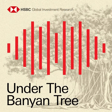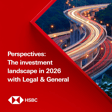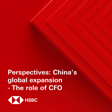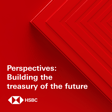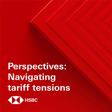Become a Creator today!Start creating today - Share your story with the world!
Start for free
00:00:00
00:00:01

The Macro Brief – Market resilience amid global risks
Janet Henry, Global Chief Economist, looks at how the world economy is muddling through despite substantial challenges, while Ali Cakiroglu, Emerging Markets Strategist, explains why investors are becoming more bullish on EM assets.
Disclaimer: https://www.research.hsbc.com/R/20/smqScSg
Stay connected and access free to view reports and videos from HSBC Global Investment Research follow us on LinkedIn https://www.linkedin.com/feed/hashtag/hsbcresearch/ or click here: https://www.gbm.hsbc.com/insights/global-research.
Transcript
Introduction to HSBC Global Viewpoint
00:00:01
Speaker
Welcome to HSBC Global Viewpoint, the podcast series that brings together business leaders and industry experts to explore the latest global insights, trends, and opportunities.
00:00:13
Speaker
Make sure you're subscribed to stay up to date with new episodes. Thanks for listening, and now onto today's show.
Episode Overview: The Macro Brief
00:00:24
Speaker
You're listening to The Macro Brief, the podcast that looks at the issues driving financial markets across the globe. This episode was recorded for publication on 25th of September 2025 by HSBC Global Investment Research.
00:00:36
Speaker
All the disclosures and disclaimers associated with it must be viewed on the link attached to your media player. And remember to like and subscribe to The Macro Brief wherever you get your podcasts.
Pressures on the Global Economy
00:00:52
Speaker
Hello, I'm Piers Butler in London and welcome to The Macrobrief. Coming up on this week's episode, pressures on the global economy are mounting, including US tariffs, questions around the independence of the Federal Reserve, and high government debt, to name just a few.
00:01:07
Speaker
Despite this, financial markets are holding up. But how much longer can this last? We'll also be combing through the latest findings of our survey of emerging market investors, which has revealed some surprising results.
00:01:19
Speaker
So to help me do all this, I'm joined in the studio by Janet Henry, Global Chief Economist, and Ali Chakiroglu, Emerging Market Strategist. Janet and Ali, thank you very much for joining us. Thank you, Piers.
00:01:30
Speaker
Great to be here.
Discussion on Global Growth Resilience
00:01:31
Speaker
So, Janet, you say in your introduction to the just published Global Economics Quarterly that 2025 has seen ongoing conflicts and geopolitical tensions, unpredictable US trade policies, increasingly precarious fiscal dynamics, and growing distrust in US institutions.
00:01:49
Speaker
And yet the global economy and US profits are holding up. How do you account for that? Well, global growth um has held up better than expected. It has, you know, in some cases more than muddled through.
00:02:02
Speaker
And what's been interesting, if you look at the data for the first half of the year, um growth in outside the US has strengthened and growth in the US has certainly been slower than it was in 2024.
00:02:15
Speaker
But for the most part, actually what has over delivered elsewhere in the world has been exports. They've been stronger than expected. Obviously a lot of this has been front-loading by US companies and consumers ahead of those tariffs, um but actually there's been resilience elsewhere, particularly by Asia um and Latin America. How much of it in Asia is transshipment and how much of its internal demand, end-user demand in Asia probably will become apparent um over time.
Consumer Spending Trends and Inflation Impact
00:02:45
Speaker
um But actually elsewhere what we've seen is that consumer spending has been a bit less impressive There have been a few exceptions. um the The ones that we highlight are India and Poland, Chile, Colombia. They're all countries where you've had strong real income growth and you've had the biggest rate cuts.
00:03:00
Speaker
And that's been helpful. But elsewhere, the uncertainty, this uncertainty overlay is weighing on growth. um ah You know, if you don't know about the future, you're careful about spending, savings rates but obviously being high in in Europe and in China.
00:03:14
Speaker
um And also the legacy of past inflation. There have been some pretty hefty price rises over the course of the last four or five years. So yeah, inflation may be lower, but prices are a lot higher than they were.
00:03:25
Speaker
Yes, just try using a builder in the UK to find out whether there's been inflation. I can vouch for that. But let's look forward now. Are we likely to see an unwinding of this growth surprise?
US Economic Outlook and Global Trade Adjustments
00:03:35
Speaker
I think there will be some payback. GDP does not tell um the full story. So we certainly are looking for some softening of growth. I think that the real payback when it comes through, it might even overstate in certain areas um the downturn.
00:03:51
Speaker
So there are certain bits that we think will hold up. um you know if we If we start with the US, for instance, um on the consumer side, ah we are looking for things to slow somewhat, but it's still a consumer story that's largely led by the higher earners who will benefit from the big, beautiful bill.
00:04:06
Speaker
less affected by tariffs and probably benefit most from what is still a roaring S&P 500, whereas other parts of the economy will will feel the tariffs, the loss of Medicaid um a little bit more.
00:04:19
Speaker
um And elsewhere, ah its there are you know even in Europe, which has really not had the outperformance on the export side and is still wary that they're seeing very strong imports from China, how much of this trade diversion story is coming through.
00:04:32
Speaker
The European story, actually real incomes are rising. It's stabilising the the household sector side in Europe. So, yeah, there'll be a bit of payback. We're looking for near term for a slowdown, but we're not looking for a sharp slowdown in growth. And we've got some stabilisation in the course of 2026, moving towards a recovery as these rate cuts feed through.
00:04:50
Speaker
We'll get to your forecast in a minute, but I wanted to ask you about inflation, where the picture is is mixed.
Inflation Dynamics and Monetary Policy
00:04:56
Speaker
In some countries, ah they're finding it really challenging to get it down, the UK, for example, and in other parts of the world, it's more disinflationary. So how do you account for that?
00:05:06
Speaker
Well, in the US, these are what we call you know big supply shocks. um So you've you've obviously got the tariffs, you've got the curbs on immigration. um They are meaning that any rate of growth is consistent now with a higher rate of inflation. We've still got a sticky inflation outlook um for the US, but the numbers are being flattered by the lower rental inflation. So even though you're seeing it in goods prices and quite sticky areas of other service sector inflation, um we still think that inflation will be sticky and actually rise a bit further from here.
00:05:36
Speaker
But those supply shocks in the US are demand shocks for the rest of the world um in terms of weaker demand elsewhere. They've also got stronger currencies. That's more disinflationary. And actually, we've lowered our inflation forecast because um energy prices have been helpful for energy importers. Energy costs are lower.
00:05:54
Speaker
And with all the LNG supply coming on stream for 2026, we think that energy might still pose some downside surprises to inflation in some countries in 2026 in that area. but But again, you've got differences and a lot of that is domestic.
00:06:10
Speaker
You know where are inflation expectations a little bit higher, like the UK, Labour markets still tight across Europe, that's being felt, especially where you've got no productivity growth. You see that in higher wage growth.
00:06:22
Speaker
It's the service sector, inflation resilience, um that that's where you're still seeing it in what is a broad disinflationary pressure picture, particularly in Asia. So you said in in your response that US inflation was a bit sticky. So why are you expecting the Fed to ease a bit faster than expected?
00:06:39
Speaker
Well, as you know, Piers, we've had this long-held view that the Fed would only cut interest rates by 75 basis points by the end of 2026. And we've long been forecasting that it would get there by March 2026. We now think it will happen a little bit more swiftly.
00:06:56
Speaker
um It's obviously uncertain, but we have got the Fed cutting rates at the next two meetings. And the reasons for that is is the Fed's dual mandate. um The fact that um the risks to inflation are still to the upside But the risks to the labour market are to the downside.
00:07:13
Speaker
So when policy is starting from a restrictive position, um Chair Powell has said that the balance of risks is coming closer into balance because there are now these downside risks.
Predictions for 2027: AI, Debt, and Trade Frictions
00:07:25
Speaker
um to the labour market and therefore policy needs to be a bit less restrictive. So um we still think the market's pricing in too much um but there is scope for for policy to be cut a couple more times, for the policy the Fed funds rate to be cut a couple more times and still in our view be neutral.
00:07:43
Speaker
We do not think the Fed needs to go super accommodative um with with big rate cuts. So yeah. think the market is pricing in too much, but I suspect at least some of that is because they think we are now looking at a much more politicised Federal Reserve.
00:07:57
Speaker
So let's get to your forecasts, which now include some attempt at telling us what's going to happen in 2027. Yes, obviously, 2027 is quite a long way off at the moment, given all the events that are due to take place in 2026, including the US midterm elections later in the year.
00:08:17
Speaker
But in terms of what's in our forecast, it is a view that we'll be back to kind of potential growth. And so when you think about potential growth, um it will be lower with what we saw in the pre-pandemic period. We are talking about a world with a lot more trade friction, even if we still got bilateral and regional trade deals.
00:08:35
Speaker
um And we are talking about a lot of countries, particularly in the West, being a lot less open to immigration. So you've got lower um labour force growth. ah so So growth being a bit lower um in nearly every economy relative to where it was um in a pre-pandemic period.
00:08:51
Speaker
Obviously, there are risks, upside and downside. The upside risk being AI. i think we're still going to be having this AI investment boom. That will help demand. But I don't think we see the productivity boost. That's probably more a 2030s story.
00:09:05
Speaker
And the big downside risks, well, that they have to stem from government debt.
Global Growth Projections and EM vs. Advanced Economies
00:09:10
Speaker
So in broad numbers, what are the GDP forecasts that you're going for for 26 and 27, say developed markets and emerging markets?
00:09:17
Speaker
Well, our global growth numbers really for the next couple of years. So in 2026, we're at 2.5 and in 2027, we are at 2.6. And that's based on nominal GDP weights. And to give you an idea, um the split is, where you know, we think Potential growth is probably in the advanced economies about one and a half and in the emerging economies is probably still above four.
00:09:39
Speaker
But that is a picture that is weaker than we saw, say, back in 2017, 2018, when global growth was running at more like 3.3 to 3.5. um global growth was running it more like three point three to three point five It seems hard to believe, just to finish on on your global economics quarterly, I read that some central banks you're forecasting may start to tighten in 2027. Again, it's a long time off.
00:10:00
Speaker
But yes, we have put in um the first rate rises, the first tightening um in 2027. I mean, actually, um we think that the Australian may even raise rates. Australia might be by the end of 2026.
Central Banks' Future Rate Decisions
00:10:15
Speaker
um But we have unpenciled in 50 basis points of of rate rises from the ECB and from Sweden um by the end of 2027. um And it is based on this idea that the speed limit for growth is low. We are in in a world of of shrinking populations.
00:10:30
Speaker
um And actually, despite weak growth, um we've we've got tight labor markets and the service sector inflation is not, we don't see big downside risks to it. So the central banks have to move to anticipate that sort of tightening of the labor markets and the impact on inflation. Yeah, absolutely.
00:10:46
Speaker
So Ali, if I can turn to you now, ah the gap between emerging markets and developed markets growth in what we've just talked ah with Janet about is significant.
Emerging Markets Sentiment and Investment Backdrops
00:10:55
Speaker
i mean, we're talking about two and a half, 2.6 maybe percentage points.
00:11:00
Speaker
Is that what's behind investors' bullishness in this latest edition of the EM Sentiment Survey that you've just published? It looks like there's been a significant change in expectations. Indeed, I guess it's one of the factors, but it's not the only one.
00:11:13
Speaker
Because when we look at the survey results, we've seen quite significant improvement. Now the bullish views is 62%, the second highest in our survey's history. And the bearish views have halved to 7%. So the net sentiment is 55%. Which is really big, isn't it? It is very big. indeed, and this is also the second highest number.
00:11:34
Speaker
And I guess, you know, on top of what Janet mentioned in terms of the economic activity or emerging markets still growing strong, there's also this moderation in the perception about the downside risks based on our survey results.
00:11:48
Speaker
In the previous survey, the tariffs, trade tensions were highlighted as the top risk and by 33 percent of survey respondents, this has come down to 28 percent. So some moderation there.
00:11:59
Speaker
And also recession worries in major economies have moderated as well. In the previous survey it was 27 percent, now it's 22 percent. And I guess one point worth highlighting here is the fact that, you know, in our June edition, 65 percent of survey respondents saw that a U.S. recession was highly likely or, you know, somewhat likely.
00:12:19
Speaker
In this survey run, it has come down to 45%. So, yes, moderation in downside risks is improving economic activity ah in emerging markets, but also some, you know, expectations of ongoing disinflation in the emerging world.
00:12:34
Speaker
So, in a sense, everybody's kind of recovered from the Liberation Day shock, which everybody was kind of like, my God, what's going on? But... Key question here, why has risk appetite not picked up? Is it like they want to, but they don't dare to?
00:12:49
Speaker
I guess there are a couple of you know answers to that. The first one I would say is when you look at the current positioning, actually current positioning has picked up quite significantly, particularly for local currency markets, be it local currency debt or equities or FX.
00:13:03
Speaker
But on top of that, you know it's still a complex backdrop when you think about, you're talking about you know ongoing investment answer uncertainties on the trade and tariffs front. And on top of that, there's you know some soft labor data coming out of the U.S., which is you know still complicating the outlook, rising worries about a U.S.-led sort of a recession.
00:13:24
Speaker
And all these, to some extent, maybe prevent investors to add more exposure to and increase their you know risk appetite towards em emerging markets.
Investment Opportunities in Latin America and Asia
00:13:32
Speaker
But at the same time, I guess one point worth highlighting again here is the fact that when you look at the overall ah sentiment, it's still quite significant.
00:13:44
Speaker
So are we saying that they have a very positive perception and they kind of poised to act? what would What would be catalyst in your experience of the survey? is that is that Is the survey telling you that they're ready to commit themselves, but they need further evidence before they do so?
00:13:58
Speaker
you're You're right. I mean, when you look at the you know the cash holdings of investors, they still hold a sizable amount of cash um in their portfolio, which means that there's still quite a sizable amount that can be put to work.
00:14:10
Speaker
But I guess they still wait to sort of ah some stabilization in some of those uncertainties, be it trade or tariff tensions or you know the outlook for the U.S. s economic activity.
00:14:20
Speaker
What else stood out for you in in the survey? Any significant changes, for example, in regional or country preferences? We've seen some of those in the past before. ah We did indeed. And in this survey, we have also seen some you know changes in terms of the investors' perception towards some of these regions.
00:14:37
Speaker
Latam, for instance, stands out as the region for fixed income ah markets. Investors have turned quite positive on a net sentiment basis, both for local currency debt and hard currency debt.
00:14:48
Speaker
Asia is still the most preferred region for equities. And as a matter of fact, investors have up there, you know, bullish expectations for mainland Chinese equities. And now quite a significant amount of investors see the Chinese equities are more favorable.
00:15:04
Speaker
Apart from that, we have seen some moderation in the sentiment for EMFX. I guess there are a couple of reasons for that. When you look at you know, the survey was conducted between 4th of August until the 15th of and September, and this was an episode where US dollar was broadly stable. So this might have led to some sort of, you know, stabilization or leg lower in the overall net sentiment.
00:15:27
Speaker
For equities, investors are still very positive, I would say. More than two-thirds of survey respondents expect EM equities to be higher over the next three months and more than 60% expect them to outperform their developed peers. So overall quite bullish sentiment and a large part of that is the result of this, you know, ah moderation in, you know, expectations towards downside risks.
Key Upcoming Economic Events
00:15:50
Speaker
So we'll have to see whether that bullish sentiment translates into a higher risk appetite. We'll have you back for the next survey. But Janet, just to finish on, what are the big macro events our listeners should be watching out for in this coming quarter?
00:16:03
Speaker
I can think of the UK budget in November as one. any others that you would highlight? oh Well, if we're talking about budgets, France has still got one to pass. Of course, they've got to pass budget. By the end of the year. um And that's not easy to do when you are a minority government trying again with another prime minister.
00:16:20
Speaker
um But that needs to be passed um by the end of the year. um Although I think to some extent the markets are priced in the fact you're not getting anything dramatic on the fiscal tightening before 27 when you you have a presidential election.
00:16:32
Speaker
um ah Other big events, um more tariff news. We're not finished with tariffs and we should get the Section 232 reports on pharmaceuticals and semiconductors by the end of the year. And that won't be the end. There are other reports due um in early 2026.
00:16:46
Speaker
twenty twenty six So, yes. and isn't there Is there a court case as well around tariffs? there are yes um there's a queue of court cases queuing up at the Supreme Court um but there are two key ones one relating to Fed Governor um Lisa Cook as to whether the president is allowed to fire her with cause um and the other key one is on the um ah use of the emergency powers to impose um those initial reciprocal tariffs I mean to some extent some of them have been overtaken by laterteral bilateral trade deals so yes budgets
00:17:20
Speaker
U.S. Supreme Court um are really the two things, the two key events um that we need to to focus on. So as the saying goes, there's no finish line. You'll be kept busy, I'm sure, for this coming quarter. But I think that's all we have time for today. So Janet and Ali, thank you for joining us. Thank you very much, Thank you very much, Piers.
00:17:40
Speaker
Before we go, a reminder to check out the latest edition of our sister podcast, Under the Banyan Tree, where hosts Fred Newman and Harold van der Linde put Asian markets and economics into context.
00:17:51
Speaker
This week, they're chatting to Pranjal Bhandari about the outlook for India's economy.
HSBC Global Research Resources and Contact Information
00:17:56
Speaker
Don't forget that the HSBC Global Research Investment app is available to our clients. It features all of our latest reports, and it can now read out our research to you with its listen functionality.
00:18:08
Speaker
Just head to Apple's App Store or Google Play to download it. And finally, you can get in touch with us at askresearch at hsbc.com if you have any questions or comments.
00:18:20
Speaker
So that's all from us this week. Thanks for listening and please join us again next week on The Macrobrief.
00:18:50
Speaker
Thank you for joining us at HSBC Global Viewpoint. We hope you enjoyed the discussion. Make sure you're subscribed to stay up to date with new episodes.

